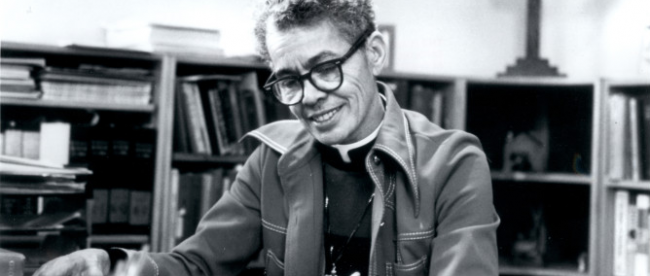The Weekender, August 4, 2017

1) “The Many Lives of Pauli Murray” (The New Yorker, 21 minutes, April 2017). The subhead: “She was an architect of the civil-rights struggle—and the women’s movement. Why haven’t you heard of her? ”
The wager was ten dollars. It was 1944, and the law students of Howard University were discussing how best to bring an end to Jim Crow. In the half century since Plessy v. Ferguson, lawyers had been chipping away at segregation by questioning the “equal” part of the “separate but equal” doctrine—arguing that, say, a specific black school was not truly equivalent to its white counterpart. Fed up with the limited and incremental results, one student in the class proposed a radical alternative: why not challenge the “separate” part instead?
That student’s name was Pauli Murray. Her law-school peers were accustomed to being startled by her—she was the only woman among them and first in the class—but that day they laughed out loud. Her idea was both impractical and reckless, they told her; any challenge to Plessy would result in the Supreme Court affirming it instead. Undeterred, Murray told them they were wrong. Then, with the whole class as her witness, she made a bet with her professor, a man named Spottswood Robinson: ten bucks said Plessy would be overturned within twenty-five years.
Murray was right. Plessy was overturned in a decade—and, when it was, Robinson owed her a lot more than ten dollars. In her final law-school paper, Murray had formalized the idea she’d hatched in class that day, arguing that segregation violated the Thirteenth and Fourteenth Amendments of the United States Constitution. Some years later, when Robinson joined with Thurgood Marshall and others to try to end Jim Crow, he remembered Murray’s paper, fished it out of his files, and presented it to his colleagues—the team that, in 1954, successfully argued Brown v. Board of Education.
2) Support Now I Know: As many of you already know, researching, writing, and (save for the daily typo or two) editing Now I Know is a pretty big endeavor on my part. Keeping the project financially sustainable is a battle, and to that end, I’ve tried many different avenues.
One of them — a major one at that — is my ongoing Patreon campaign. It’s an old-style patronage campaign, where readers such as yourself support Now I Know through a monthly pledge. A $5 a month pledge comes out to about 25 cents per article I send; a $1 a month pledge is roughly a nickel. Please consider supporting Now I Know through Patreon by clicking here. It’s entirely optional and you’re under no obligation to do so, so don’t feel bad if you can’t or don’t want to. But if you do, please know it all adds up, and I greatly appreciate your support. Thanks!
3) The Now I Know Week in Review:
Monday: Why We Wake Up With Crusty Eyes. This was the hardest Now I Know to write in a very long time, not because the topic was particularly dense, but because my eyes were watering throughout.
Tuesday: The Poop Collector. Hey, we all have hobbies.
Wednesday: The Balloon Expedition to the North Pole That Was a Bust. I was particularly amused by the bonus fact in this one.
Thursday: Cold Water War — the swimming pool standoff between the Soviet Union and China.
4) “Four Columbia House insiders explain the shady math behind ‘8 CDs for a penny‘” (AV Club, 37 minutes, June 2015). If you don’t know what Columbia House was, feel free to skip this one. If you do know about it, though, you were probably wondering how a music label could sell you eight CDs — which retailed for $15 easily — for $0.01. Here’s the story, and how the math works out.
WeekenderAdUnits
5) “The Lethality of Loneliness” (The New Republic, 21 minutes, May 2013).
Sometime in the late ’50s, Frieda Fromm-Reichmann sat down to write an essay about a subject that had been mostly overlooked by other psychoanalysts up to that point. Even Freud had only touched on it in passing. She was not sure, she wrote, “what inner forces” made her struggle with the problem of loneliness, though she had a notion. It might have been the young female catatonic patient who began to communicate only when Fromm-Reichmann asked her how lonely she was. “She raised her hand with her thumb lifted, the other four fingers bent toward her palm,” Fromm-Reichmann wrote. The thumb stood alone, “isolated from the four hidden fingers.” Fromm-Reichmann responded gently, “That lonely?” And at that, the woman’s “facial expression loosened up as though in great relief and gratitude, and her fingers opened.”
Fromm-Reichmann would later become world-famous as the dumpy little therapist mistaken for a housekeeper by a new patient, a severely disturbed schizophrenic girl named Joanne Greenberg. Fromm-Reichmann cured Greenberg, who had been deemed incurable. Greenberg left the hospital, went to college, became a writer, and immortalized her beloved analyst as “Dr. Fried” in the best-selling autobiographical novel I Never Promised You a Rose Garden (later also a movie and a pop song). Among analysts, Fromm-Reichmann, who had come to the United States from Germany to escape Hitler, was known for insisting that no patient was too sick to be healed through trust and intimacy. She figured that loneliness lay at the heart of nearly all mental illness and that the lonely person was just about the most terrifying spectacle in the world. She once chastised her fellow therapists for withdrawing from emotionally unreachable patients rather than risk being contaminated by them. The uncanny specter of loneliness “touches on our own possibility of loneliness,” she said. “We evade it and feel guilty.”
Her 1959 essay, “On Loneliness,” is considered a founding document in a fast-growing area of scientific research you might call loneliness studies. Over the past half-century, academic psychologists have largely abandoned psychoanalysis and made themselves over as biologists. And as they delve deeper into the workings of cells and nerves, they are confirming that loneliness is as monstrous as Fromm-Reichmann said it was. It has now been linked with a wide array of bodily ailments as well as the old mental ones.
6) “Your Friend’s Phish Obsession, Explained” (Thrillist, 11 minutes, July 2016). I know a lot of people — mostly from high school — who go to three or four Phish shows in a row whenever the band is in town. And I didn’t really understand this, at all. I still don’t, but the article helped a lot.
Have a great weekend!

